With an about 4,700-year history of tea culture, China is unapologetically a cradle of tea. Our 12 days China tea tour will deliver you a wonderful chance to enjoy the superb tea and appreciate the tea ceremony. Meanwhile, the cultural heritage sites such as Shanghai Old Streets, Tianzifang Market, and Nanjing Road will evoke the life of ordinary people in the old times. What’s more, the fascinating imperial architecture like the Forbidden City and the Summer Palace shows the previous gory of the great ancient civilization. During the Wuyi tea tour, your mind will be purged of any annoyance in life while you’re fully returning to nature on Wuyi Mountain. Besides, Wuyi oolong tea tour includes many interesting scenic areas like Tea Cave and Dahongpao Scenic Area so that you can explore the origin of tea culture. Then in Hangzhou, Longjing Tea Plantation will enable you to know more about tea by presenting you with the best growing conditions of tea.

Welcome to Shanghai! Upon your arrival, our tour guide will pick you up at the airport and you will be transferred to the hotel. After check-in, you can have a good rest and get prepared for your upcoming travels in China.
With an area of 6,340 square kilometers, Shanghai has a persistent population of about 24,280,000. Dubbed as a magic city, it is blessed with enchanting rich culture, especially city culture in modern times. Since 1843 when it was opened up to the rest of the world, the city has rapidly grown up to be the largest city in the Far East. Now, Shanghai has successfully held many major international events like the World Expo, China Shanghai International Art Festival, and Shanghai International Film Festival. Meanwhile, with the integration of modernity and antiquity, the metropolis boasts numerous attractions such as vibrant modern skyscrapers and mystical historical sites. Undoubtedly, Shanghai is a perfect outset of your holiday.
After breakfast, let us begin with Yu Garden (closed on Monday). As a typical classical garden, Yu Garden has been over four hundred years old. As the name suggests, Yu means peace and delight in Chinese. Differing from the clamor and glamour of the international metropolis, Yu Garden will deliver you pleasure from serenity. You can find a wide variety of traditional Chinese handicrafts like silverware, stone carvings, and jade ornaments. Luscious food here like steamed dumplings is second to none. Among multiple sightseeing highlights there, Zigzag Bridge may catch your eyes. It’s believed that you will elude all difficulty and affliction in your life and get peace and prosperity by walking across the bridge. So, you have every reason to take a walk on it. The bridge leads to Mid-Lake Pavilion which is a superb teahouse for you to explore tea culture. In the quaint pavilion surrounded by the relaxing ambiance, you can appreciate the tea ceremony performance. With aromatic tea and exquisite teaware, the graceful performer will show you the process of making tea. From warming teaware to cooling down boiling water and to putting the tea into the cup, you will find yourself fascinated by the elegant movements of the performer. From moistening tea to brewing and steeping tea, the aroma of tea permeates in the air. When you are invited to taste tea, you will be asked to see and smell the tea before drinking it. Wow, what an enjoyment!
The next stop is Shanghai Old Street. With a length of 825 meters, Shanghai Old Street evokes a vision of the prospering market of the old Shanghai a century ago. Historically, it was home to the earliest banking house, gold shop, trading company, teahouse, etc. in Shanghai. In this ancient town, residents maintain a leisurely lifestyle. Walking along the winding street, you can feel the long history of stores and private houses. The main street has divided the town into two sections. The east section is characterized by dwellings in the late Qing Dynasty (1636-1912) while the west section features the buildings modeling architectures in the Ming (1368–1644) and Qing Dynasties. You can go to a teahouse to appreciate the charm of Chinese tea culture and taste some local snacks in the time-honored stores.
After lunch, you are supposed to go to Tianzifang Market. Brimming with vigor and vitality, this market is an art street with many crafts shops. Since many famous Chinese painters came here for opening their studios, it has been popular among ambitious young artists both at home and abroad. Right now, artist groups from ten counties and regions have set up design offices and studios in this place. When you come here, you will get to know more about fashion.
Out of Tianzifang Market, you will be taken to Shanghai Tower, the highest building in Asia. Built for ten years, the skyscraper can accommodate forty thousand people. With cutting-edge technology and meticulous design, the safety of the spirally rising tower is well ensured. There is a damper of 1000 tons in the building to defend against typhoons and earthquakes. Its express lifts can deliver you to its 118-floor Observation Deck within 55 seconds from the ground. The Observation Deck will present you with a panoramic view of Shanghai. So please take a breath, and expect a thrilling experience in the tower.
After the visit, you will be transferred to the hotel.
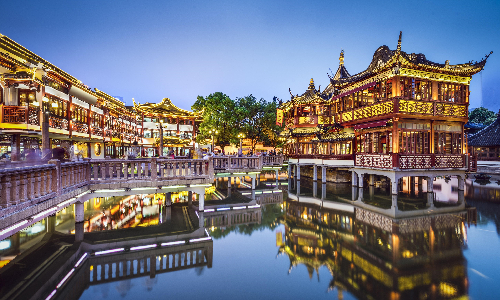
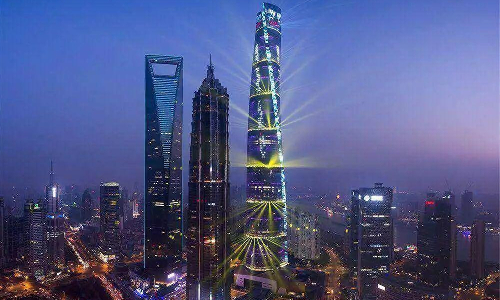
Today, get prepared for the visit to three destinations. The first one is Zhujiajiao Water Town to the west of Yu Garden. After a one-hour drive of 50 kilometers, you will arrive in this ancient town. It’s a famous historical and cultural town, located at the junction of Jiangsu Province, Zhejiang Province, and Shanghai Municipality. With such a good location, it serves as a critical transportation hub in the region. Nine long streets stretch along the crisscrossing rivers with quaint bridges spanning over them. Thousands of architectures in the Ming and Qing Dynasties stand beside lucid water. Indeed, you will be surprised that such a well-preserved ancient water town can be found in the outskirts of cosmopolitan Shanghai. What’s more, you will have a chance to get on a wooden boat drifting on the river to appreciate the beauty of the town.
After 1.5 hours on an eastward ride of 50 kilometers, you will reach the Bund, an epitome of opening up of China. As the most prosperous place in China over a century ago, the Bund maintains the boom now. With a length of 1.5 kilometers, the Bund faces the Huangpu River on the east. In its west stand 52 buildings of different styles, known as the exotic building clusters. They were built by the British and the French and are over 100 years old. You may hear the tolling of the big bell of the customs building in the distance on the Bund. This building was once a place where British officials collected taxes. Next to it is Shanghai Pudong Development Bank, a domed structure known as the most beautiful building in the Far East.
Next, you will go to Nanjing Road, a must-see spot in Shanghai. The road of 5.5 kilometers is the first commercial street in Shanghai. The four great department stores on this road once set numerous precedents in the department store industry in Asia. For instance, they first adopted escalators and air conditioners, and their workers first wore uniforms. One of them also hired the first waitress in China. In the past, it was very hard to see a woman on the street as women in the old society rarely went outside in China. So this event caused a sensation in Shanghai. Nanjing Road is also home to flagship stores of many big brands such as Nike and Champion. So come here and explore this eventful street.
After a day-long visit, you will be taken back to the hotel for rest.
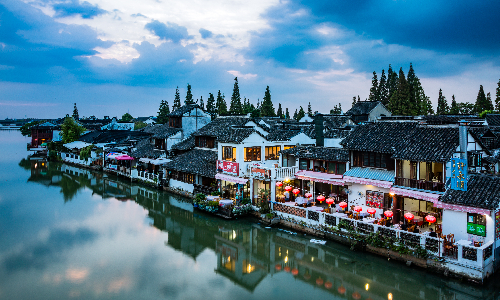
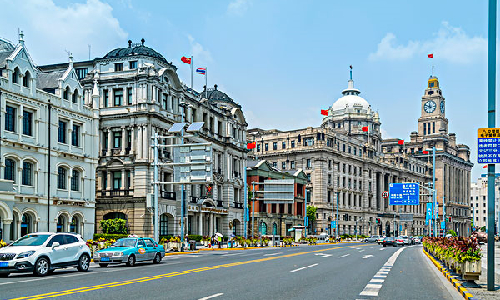
 Wuyi Mountain
Wuyi Mountain Today, you are scheduled to leave for Nanping, where Wuyi Mountain and oolong tea are awaiting you.
After breakfast, the guide will help you with check-out and send you to take the estimated high-speed train G1653 08:41/12:30. Upon arriving, you will be transferred to Wuyi Mountain. Known as the First Famous Mountain in Fujian Province, Wuyi Mountain features a typical Danxia landform (the continental red bed landform with escarpments). As a World Cultural and Natural Heritage Site, the mountain boasts a large native forestry ecosystem with 2,527 plant species, almost 5,000 species of wild animals, and numerous relics of temples and monasteries. Deemed as a holy mountain of Buddhism, Taoism, and Confucianism owing to its unique and favorable natural environment, it attracted many literati, generals, officials, and masters in antiquity for traveling, seclusion, writing, or teaching. Until now, it remains popular among Chinese and foreign tourists, especially tea lovers. Wuyi Mountain is blessed with more than one thousand types of oolong tea, such as Dahongpao, Tieluohan, Shuijingui, Baijiguan, and Bantianyao. Among them, Dahongpao is the most renowned for its pervasive fragrance. No wonder, it’s the best place for you to delve into tea culture.
So let us begin the excursion to Wuyi Mountain. First, you will be taken to Tianyou Peak, 408 meters above sea level. On its top, you will have a panoramic view of the great mountain. There is a spring on the peak that flows down the cliff wall. It looks like a river flowing down from heaven. As such, the peak was highly praised by Chinese geographer Xu Xiake in the Ming Dynasty. Next, you will be led to Yunwo, which means clouds cave in Chinese. You will see lots of clouds hovering over a cave just like plumes of smoke from cooking. Surrounding high mountains and lucid water plus the mist floating in the air, that view delivers you a sense of mystery. The last stop is Tea Cave. It’s said an immortal planted the first tea tree in the cave, and later a tea garden gradually formed there. Surely, you can get to know more about tea culture through this place attracting tea lovers.
As the visit ends, you will be taken to the hotel.
Option evening activity:
If you are eager to explore the essence of tea culture and appreciate the charm of Wuyi Mountain, Impression Da Hong Pao is the best choice. It’s a splendid show that presents the beauty of Wuyi Mountain at night. The tea-themed performance features storytelling and participation, demonstrating a picture of life and culture on the mountain. With luscious music and costumes, a large number of performers show the history of tea, tea-making crafts, and love stories. It will not fail you.


After breakfast, let us begin today’s expedition to Dahongpao Scenic Area, famous for the millennium-old Dahongpao tea trees. Dahongpao means big red robes in Chinese. It’s said that when a young man stopped at Wuyi Mountain on his way to the capital city for the imperial examination, he got an acute stomachache. A monk on the mountain gave him a cup of tea from these tea trees, and he got well soon after drinking it. Later the young man became the Number One Scholar. Being grateful for being healed, he put his great red robe awarded by the emperor on these tea trees. Thus, the tea got the name Dahongpao, meaning great red robe in Chinese. Now there are only four Dahongpao trees left that are over 350 years old. So, the trees are so precious that 20-gram Dahongpao tea from these trees was once priced at 198,000 yuan ($30,658) in 1998. You will be led to Water Curtain Cave on foot. This cave is the largest cave on the mountain, with its height and width both above one hundred meters. Two long waterfalls are pouring down like two water curtains in front of the Water Curtain Cave. You will find many beautiful Chinese characters carved on the cliffs there. They are poems written in different dynasties to praise the fantastic landscape.
In the afternoon, you will explore Yixiantian Scenic Area, where there is the most marvelous rock cave of Wuyi Mountain. Yixiantian is really a wonder of nature. With an average width of one meter, it is 178 meters long and 30 centimeters wide at its narrowest section. In this deep and narrow crevice, you can only see a chink of sunlight during the good weather.
Next, the guide will take you to Tiger Roaring Rock to the north of Yixiantian. Entering the sightseeing spot, you will hear winds roaring like tigers, and that’s why it’s called Tiger Roaring Rock. Under the foot of the huge rock is a tea plantation. On its top, all major peaks of Wuyi Mountain will be in your sight and scenes from any angle are picturesque.
As the day-long expedition ends, you will be transferred to the hotel.
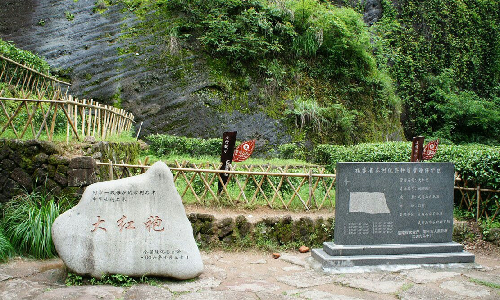
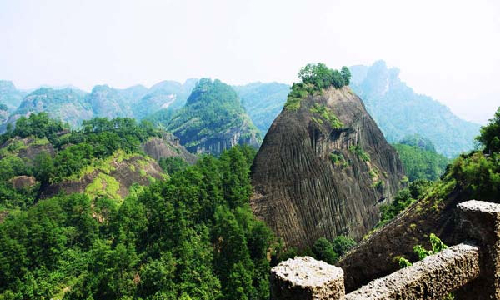
 Hangzhou
Hangzhou Today is the last day in Wuyi Mountain, and the Chinese tea culture tour continues with the expedition to Xiamei Ancient Village, a crucial spot to explore tea culture. Tucked away to the east of the Wuyi Mountain, Xiamei Ancient Village is encompassed by mountains and waters, with only about 2,100 people living there. Despite its small size, the village, as the first stop of tea road of thousands of kilometers, has been a distribution center for the Wuyi Mountain tea trade since the Ming and Qing Dynasties. Boasting a wide range of cultural and natural landscapes, it has become a popular location for films and TV dramas. There is a 900-meter manmade canal crossing through this enclosed village. You can also have a chance to watch paper cutting, dragon dance, and traditional cultural production.
After lunch, you will be transferred to take the estimated high-speed train G1642 16:02/18:32 to Hangzhou. When you arrive there, our tour guide will pick you up at the railway station and send you to the hotel. Then you can have a good rest, expecting a wonderful visit tomorrow.


Today, Hangzhou tour begins! The first spot is West Lake Scenic Area. Located in the west of Hangzhou, West Lake is undoubtedly the most prestigious freshwater lake in China. With an area of 6.39 square kilometers, West Lake is surrounded by mountains on its three sides. The West Lake Scenic Area is much larger, covering 59.4 square kilometers. There are ten major visiting spots in the large area, among which Melting Snow at Broken Bridge is the most romantic. Broken Bridge is a long quaint bridge over the West Lake. Legend has it that a small white snake caught by a hunter was saved by a little shepherd. One thousand and seven hundred years later, the snake turned into a fairy. To requite the shepherd for saving her life, she tried to find his reincarnation for a long time. Eventually, they met on the Broken Bridge and fell in love at the first sight. Then they got married and had a happy marriage. However, a powerful monk suddenly interfered in their life. He claimed that as the fairy was a snake spirit, she was not allowed to live together with mortals. To defend her marriage, the fairy was forced to wield her magic power to fight with the monk. But the fight was so fierce that water from the West Lake overflowed and flooded the entire Hangzhou area. At last, she was imprisoned by the monk. After many years, she was released and finally met with her husband on the Broken Bridge again. Although many years have passed, her husband still loved and waited for her. Since then, they had been living happily ever after. You will take a West Lake Boat passing by the Broken Bridge.
After lunch, let us go to Feilai Peak. The 168-meter–high peak boasts many caves with their respective legends and bizarre stones that look like animals. There are about 470 rock cave statues carved in different dynasties.
The next spot is Lingyin Temple opposite Feilai Peak. Covering an area of 87,000 square kilometers, Lingyin Temple was built by a monk called Huilin from India in 326. There are three major halls in the temple, among which Heavenly King Hall is the most famous. Being 24 meters long and 15 meters wide, the hall houses a huge priceless Buddha statue of more than 700 years old. On the gate hangs a big plaque with four Chinese characters written by Emperor Kangxi in the Qing Dynasty. It’s a place of blessings, and you can get a sense of seclusion and serenity.
After that, you are scheduled to have a Longjing tea tour in Longjing Tea Plantation and enjoy the rich tea culture. Hailed as the “Queen of Green Tea”, Longjing Tea tops the ten famous tea varieties of China. Longjing Tea Plantation produces the best tea of its kind due to its favorable natural environment. The fertile land, surrounding flora, and topographic features all contribute to the superb quality of Longjing Tea. Located in Longjing Village, the six-square-kilometer plantation presents a beautiful picture with layers of tea trees surrounded by luxuriant mountains. Emperor Qianlong (1711-1799) came here four times to appreciate Longjing Tea. It’s said that one day, he was learning to pluck tea leaves when the news came that his mother was sick. After hearing that, he incidentally put some leaves into his sleeves (the ancient Chinese had large sleeves and there is a small pocket inside for put small things) and rushed back to the imperial palace. Upon seeing his son came back, the Queen Mother felt better. Soon she smelt the fragrance of the tea in his sleeves. Then the emperor had the tea brewed for his mother to drink. After drinking it, the Queen Mother was surprisingly healed. Later on, Emperor Qianlong designated 18 tea trees in the Longjing Tea Plantation as “Imperial Tea”. When you get there, you will have a look at them.
After the impressive experience on the plantation, you will be transferred back to the hotel.
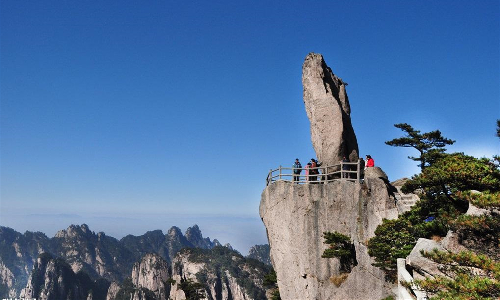
 Beijing
Beijing Say goodbye to Hangzhou! The guide will send you to the airport. You will board the estimated flight MF8129 09:20/11:50 to Beijing Daxing Airport.
Upon arrival, the guide will pick you up and take you to visit the Hutongs. Being over 700 years old, the Hutongs bear witness to the long history of Beijing. Dating back to the Yuan Dynasty (1271-1368), these distinctive lanes are passages of enclosed quadrangles. They connect dwellings on both sides and protect residents from hustle and bustle of markets outside. They are typically narrow and long. The narrowest Hutong is 0.4 meters wide and the longest Hutong is 6,500 meters. Luckily, you can take a rickshaw tour along the Hutongs. On the rickshaw, you can hear some interesting stories that happened in Hutongs from the guide.
After the tour, let us head to Beihai Park. With an area of 682,000 square meters, Beihai Park is one of the best-preserved imperial gardens in China. The millennium-old park is in close connection with the development of Beijing city. Dating back to the Liao Dynasty (907-1125), it served as an exclusive imperial place continuously through expansion, renovation, and maintenance until the Qing Dynasty. The garden is divided into four major scenic areas, namely North Shore Scenic Area, East Shore Scenic Area, Qiongdao Scenic Area, and Tuanchen Scenic Area. It’s a poetic park with picturesque sceneries in almost every corner.
Out of the park, you will be sent back to the hotel.
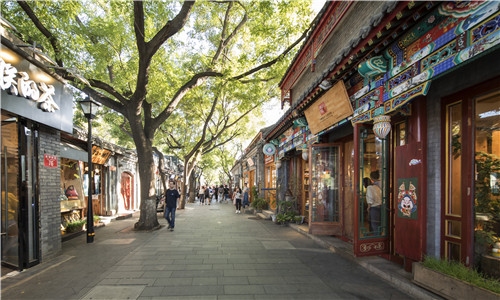

In the morning, the guide will take you to visit Tian’anmen Square. Built in 1417 in the Ming Dynasty, Tian’anmen Square is a place steeped in history. Covering 440,000 square meters, the broad square has a capacity of one million people for a grand rally. In its center stands the Monument of the People’s Heroes and Chairman Mao Zedong Memorial Hall. In its west is the Great Hall of the People and opposite is the National Museum of China. Tian’anmen Tower is located in the north. It was the front gate of the imperial city of both the Ming and Qing Dynasties. It used to seem a token of feudalism, but now it’s deemed as the symbol of the People’s Republic of China.
Behind Tian’anmen Square is the world-renowned Forbidden City (closed on Monday). Topping the world’s five greatest palaces (namely the Forbidden City, the Palace of Versailles, the Buckingham Palace, the White House, the Kremlin), the Forbidden City is the world’s largest and best-preserved imperial palace. Built in 1406, it is a rectangular city, with a 52-meter-long moat outside and encompassed by a 10-meter-high city wall. The imperial palace is comprised of two parts: outer court and inner residence. As the imperial palace in the Ming and Qing Dynasties, this huge palace was where 24 emperors ascended to the throne. The architecture of the Forbidden City emphasized the supremacy of imperial power. Especially the two huge bronze lions in front of the Gate of Supreme Harmony look awesome. The two 4.4-meter-high lions on the pedestals radiate a sense of majesty. The female lion on the right is playing with its cub under its left front paw, symbolizing fertility, while an exquisite ball is under the right front paw of the male lion on the left, implying unification of the world. So please take a deep breath and appreciate the wonder of human architecture.
After lunch, you will be taken to the Summer Palace. Hailed as “the Imperial Garden Museum”, the Summer Palace is the best-preserved and largest imperial garden in China. With an area of about 290 hectares, the palace is divided into administrative, living, and sightseeing sections according to their functions. As the center of the administrative area, the Hall of Benevolence and Longevity was where Empress Dowager Cixi and Emperor Guangxu of the Qing Dynasty dealt with administrative affairs and met with foreign guests. Behind the hall are three huge quadrangles that acted as imperial dwellings, among which the Hall of Jade Ripples is the most famous. In 1898, Empress Dowager Cixi launched a palace coup and confined Emperor Guangxu in the Hall of Jade Ripples. In addition, Longevity Hill and Kunming Lake are major sightseeing spots among others. In a word, the Summer Palace is a masterpiece of landscape art with ingenious design and priceless cultural heritage.
The next stop is Silk Street, the most influential international tourism and shopping market in China. Adjacent to the international Central Business District, Silk Street boasts a favorable location with convenient traffic. As the earliest free market in China, the street has been nearly 30 years old. With a wide range of distinctive goods, such as silk, pearls, ceramics, tea and artworks, it has grown up to be a popular place among tourists both at home and abroad. Even the former US President George Herbert Walker Bush spoke very highly of the fabulous products when he came here along with his daughter.
At the end of the day-long visit, you will be sent back to the hotel.
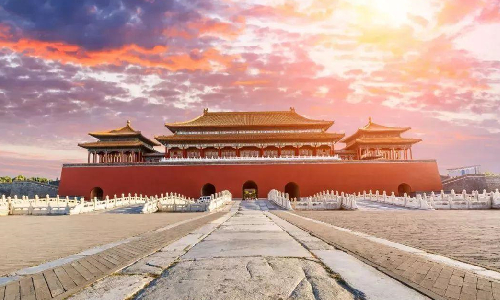
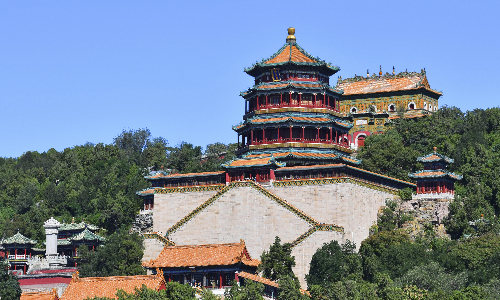
Today, let us leave the downtown for the Chang Tomb of the Ming Tombs, 50 kilometers away from downtown Beijing. After driving northwest for nearly an hour, you will arrive at the Chang Tomb. The Ming Tombs are a mausoleum cluster where 13 emperors of the Ming Dynasty were buried. Being the largest and best-preserved mausoleum in the cluster, the Chang Tomb was designed for Emperor Yongle and his wife. Built from 1409 to 1413, this splendid tomb draws great attention with its sophisticated architecture and superb construction materials. Take 60 golden Nanmu pillars for example in Ling’en Hall. Golden Nanmu is a kind of precious timber with fragrance and fine grain. It grows only in deep valleys in few provinces, which made it very difficult to transport them out. It’s estimated that the shipping cost of each golden Nanmu pillar was 12 million taels of silver. That’s a lot!
After lunch, your next destination is Juyongguan Great Wall, 23 kilometers away to the west of the Chang Tomb. After a half-an-hour drive, you will arrive at the Great Wall. Dating back to the West Zhou Dynasty (1046 – 771), the Great Wall has been built, renovated, and reinforced in different dynasties to defend against invasion. Being about 21,000 kilometers long as a whole, the magnificent defensive system is not just a wall, but also a complex defensive structure that spans 15 provinces of China. As the most precipitous section of the Great Wall, Juyongguan Great Wall is the gateway to Beijing from the northwest. In its center stands Cloud Terrace built in 1342. It is made of white marble and famous for its stone carvings, especially the four guardians carved on the inside wall of its door. It’s said that one night, Emperor Wuzong (1491-1521) of the Ming Dynasty rode his horse on a secret tour. When he went in the door of the Cloud Terrace, his horse was so frightened by the carvings of the four guardians that it stopped going forward. Then the emperor had to have the carvings blackened to get through the door. So, don’t forget to appreciate these carvings during your visit.
After that, you will be taken back to the hotel. On the back way, you will have a photo stop near Water Cube (National Stadium) and Bird Nest (National Aquatics Center).
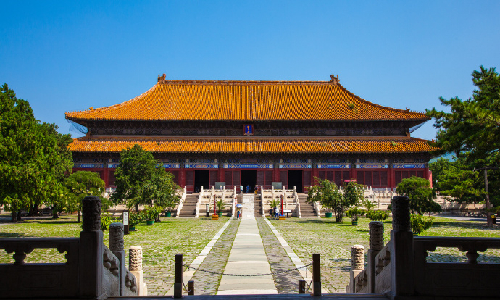

After breakfast, you will visit the Temple of Heaven. With an area of 2.73 million square meters, the Temple of Heaven is over five times as large as the Vatican. Built in 1420, it acted as a place for the Ming and Qing emperors to worship Heaven and pray for bumper harvests. Among the numerous structures, the most spectacular are the three altars, namely the Circular Mound Altar, the Imperial Vault of Heaven, and the Hall of Prayer for Good Harvests. The three complexes have two places in common, namely, round roofs and round floors, reflecting the concept that the sky is round in the minds of the ancients. Meanwhile, the concept of the number nine is integrated into the architecture, as it means infinity and eternity of Heaven in Chinese culture. For instance, outside the Circular Mound Altar are three layers of nine stone steps. On top of the altar is a round stone in the center, surrounded by nine fan-like paving stones in the inner circle and nine ones in the outer circle. In addition, during your visit, you should not miss out the Department of Sacred Music (Shenyueshu). It is known as the highest institute of ritual and music in the Ming and Qing Dynasties.
The next spot is the Lama Temple, in the northeast of Beijing. Built in 1694, the temple was a top-rank Buddhist temple in the Qing Dynasty. In the early days, it was a mansion given by Emperor Kangxi to his fourth son (Emperor Yongzheng). Later on, it became a temporary dwelling palace for Emperor Yongzheng. Afterwards, Emperor Qianlong was born here, and thus it is known as the cradle of the emperor. Therefore, buildings here boast yellow tiles and red walls in line with those in the Forbidden City. In 1744, Emperor Qianlong turned the palace into a temple. It’s a blessed place that won’t let you down.
After lunch, let us go to Confucius Temple & Guozijian. Erected in 1302 in the Yuan Dynasty, Confucius Temple was an imperial sacrificial building dedicated to Confucius (founder of Confucianism). Featuring yellow glazed tiles on the main structures, Confucius Temple was built according to the highest standards in feudal society. Differing from other temples, it has a collection of stone tablets with lists of successful candidates in the imperial examinations in the Yuan, Ming, and Qing Dynasties. Across from the temple is Guozijian, the highest institute of the royal court. It was built in 1287 during the Yuan Dynasty and covers an area of about 27,000 square meters. Guozijian enrolled not only students of all ethnic groups at home, but also foreign students, and has played an important role in promoting international exchange.
Then the last stop of today is Qianmen Street, a renowned commercial street in Beijing. Being 845 meters long and 20 meters wide, the famous street dates back to 1550 as an exclusive imperial road. There have been well-known stores on the street since the Qing Dynasty, including the first photo studio in Beijing.
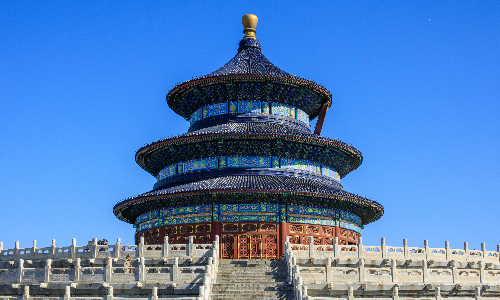
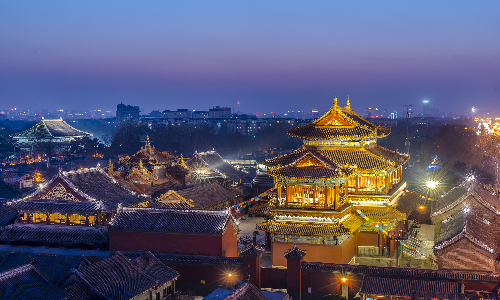
Today, it’s time to go home. The guide will send you to the airport. Hopefully, you can come to China for another wonderful tour.
Author: Wu Hongmei
Proofreader: Lexie
| City | Five Star hotel list | Four Star hotel list |
|---|---|---|
| Shanghai | Ocean Hotel Shanghai | Courtyard by Marriott Shanghai Central |
| Nanping | Ramada Plaza by Wyndham Nanping | Ramada Plaza by Wyndham Nanping |
| Hangzhou | Landison Plaza Hotel | Best Western Plus Meiyuan Hotel Hangzhou |
| Beijing | Sunworld Dynasty Hotel Beijing Wangfujing | Sunworld Hotel Wangfujing |
 |
![]() About your child or infant, please contact us for a discounted price.
About your child or infant, please contact us for a discounted price.



We started with a few days in Beijing & ended in Shanghai, from where we visited the Forbidden City and Great Wall. In between we visited Terra Cotta Warriors Museum, Panda Base, Shanghai Disneyland.

We had a wonderful holiday in China which will remain long in the memory. China is a breathtakingly beautiful country full of splendid temples and palaces, mountains and rivers, peaceful rural scenes and bustling shopping streets.
 QUICK ENQUIRY
QUICK ENQUIRY